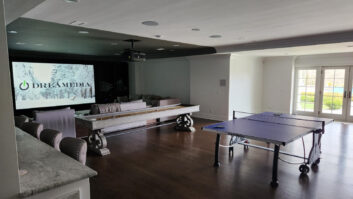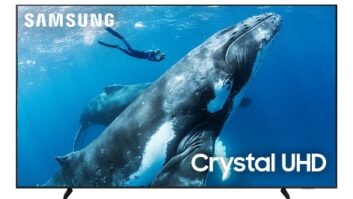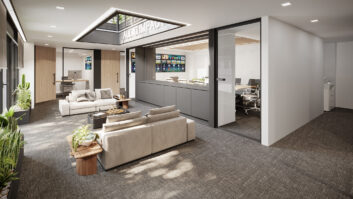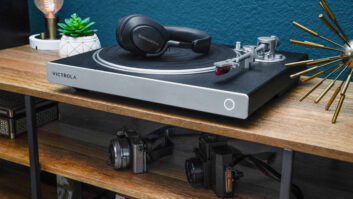CI-Grade Projectors and Screens Keep Raising the Bar for Two-Piece Systems

In a world of flat-panel TVs and touchscreens, projectors and projection screens have retained their cache as premium components within the custom integration channel. More affordable than ever while maintaining upmarket quality, these staples of top-notch home theaters have consistently improved in functionality and image reproduction, along the way, convincing reluctant customers of their unique ability to deliver a truly cinematic experience.
Today, projectors are delivering brighter images with deeper contrast and wider aspect ratios by employing a range of proprietary and popular image and lens technologies, while screen manufacturers are improving screen functionality and surfaces to accommodate the demand for sharper image delivery. What it all adds up to is more choices for custom integrators seeking out the best combination of projector and screen to satisfy an increasingly educated and demanding client base.
“Confidence in the product is the most essential aspect of any product an integrator installs in a client’s home,” said Michael Bridwell, director of marketing for Digital Projection Inc. (DPI). “After all, our integrators are trusting us to help satisfy the clients they’ve worked so hard to find.”

Stewart’s CIMA brand was created to support Stewart dealers with products for standard commercial and residential applications. The line helps the company reinforce the benefit of finely-tuned, application specific screens, while still having something to offer for less need-specific applications.
BRIGHTNESS BOOSTS
Projectors have come a long way from the dust-ball dancing beams that punctuated many a classroom and home rec room well into the 1990s. The past decade has seen significant improvements in resolution, color wheels, lumens, and lamps, as well as the introduction of longed-for features, such as LED illumination and 3D integration, rendering that tired image of projectors obsolete. In its place are a staggering number of options for integrators to convert once off-limit areas of the home (i.e., bright living rooms and sunny dens) into viable home theater spaces.
At DPI, the focus has been on projector brightness, lamp output, and getting focused light out of the display. By way of example, Bridwell pointed to the company’s TITAN Reference Quad 1080p with its four lamps delivering 8,000 lumens, which is suitable for multipurpose media room and outdoor theater applications. But DPI has also been price conscious, and its range of LED-based projectors might strike a cord for consumers looking for value and product sustainability.
“DP has a diverse line of LED projectors, each of which is rated at over 60,000 hours of illumination life without ever replacing a lamp,” said Bridwell, who used the company’s dVision 35-1080p LED projector to underscore the range.
“The dVision 35-1080p LED has just seen an increase in luminance to more than 1,100 lumens of brightness,” he continued. “This increase, combined with the purity of the light produced by the LED diodes, means the imagery produced by the dVision LED is perceived as being far brighter than the measured specification. This is important, as it opens the door to an even wider array of installations that can enlist all the benefits that come from this Lifetime Illumination display. With more than 60,000 hours of illumination, multiple fixed and zoom lens options, low noise and heat output, and splendid DLP imagery, the dVision 35-1080p LED is a remarkable solution for custom integrators looking to wow their clients.”

JVC’s new flagship projector is the DLA-X95R, which features a 130,000:1 native contrast ratio.
LED illumination systems have also been a large part of Runco’s agenda, with the company recently receiving accolades for its QuantumColor line of projectors. Armed with the belief that the biggest barrier to projection technology adoption in the home has been its old dedicated, light-controlled theater requirements, Runco’s VP of marketing, Jennifer Davis, said that the company’s new product additions—the LightStyle LS-10HBd, the XtremeProjection X-450d, and the Signature Cinema SC-35d—which all boast nearly 4,000 lumens (uncalibrated), will show that brighter multipurpose spaces can be perfect locations for an excellent projection- based home theater. “The new XtremeProjection series is a great example of what makes these products popular with integrators and their clients alike,” Davis said. “The range of price points, the range of brightness and contrast levels for a variety of installation environments, the primary lens options and off-sets allow for lots of installation flexibility, and the CineWide and CineWide with Autoscope options allow clients to watch movies without black bars.”
Jason Palmer, marketing manager for Epson America, openly acknowledges that one of the key improvements that has allowed his company and other projector manufacturers to gain market growth, even with expanding flat-panel sizes, has been their ability to markedly increase projector brightness while simultaneously enhancing picture quality. Palmer points to Epson’s new range of full HD 1080p 2D and 3D home theater projectors to emphasize consumer attraction to front projectors as the ultimate home cinema choice.
“The Epson Pro Cinema 6020UB and Home Cinema 5020UB and 5020Ube (wireless) were designed with home cinema enthusiasts and custom installers in mind, engineered to deliver eye-popping 3D viewing at home on a big screen with up to 2,400 lumens of color brightness and 2,400 lumens of white brightness,” Palmer said. “Notably, the latest models utilize a Fujinon OptiCinema lens (2.1x zoom ratio) and offer the widest lens shift in their class (manual lens shift of up to 96.3-percent vertical and up to 47.1-percent horizontal), for superior performance, quality and installation flexibility. These projectors are also equipped with Epson’s ‘super resolution’ technology, FineFrame technology for smoother frame interpolation and sharper video quality (2D mode), and a cinema filter feature for larger color space and improved color fidelity.”

Runco’s XtremeProjection series features a range of price points and brightness and contrast levels for a variety of installation environments. At SIM2, the dedication to delivering a projector with high brightness output is a similar nod to giving integrators the flexibility to create a home theater in unlikely places. The result is the M.150 LED high-brightness projector, which Alberto Fabiano, executive vice president of SIM2 USA, describes as being “the first unit of its kind.”
“The M.150 sports a newly improved level of LED brightness that makes it the perfect unit for the living room, media room, and theaters alike,” Fabiano said. “High brightness, precision optics and light engine, servo-controlled lens, sensor calibration stabilization and more, make this projector the ideal ‘custom’ display device.”
By refining its D-ILA (digital direct drive image light amplifier) devices and light engines, JVC has consistently boosted the native contrast ratio of its projectors. “To us, high native contrast—that is, contrast that isn’t artificially enhanced through the use of a dynamic iris—is a key factor in delivering an outstanding image,” noted Dan McCarron, JVC’s national product manager for consumer D-ILA, who highlighted three JVC products as standouts.
“At the entry level there’s our DLA-X35, a $3,499 projector that’s available in black or white and offers a 50,000:1 native contrast ratio,” McCarron said. “Also at entry level, we have our new DLAX55R, or as I like to call it, 4K for $5K because it features our e-shift2 technology that upconverts full HD to 4K resolution. Then there’s our flagship unit, the DLAX95R, with an outstanding 130,000:1 native contrast ratio and a not so staggering price of $11,999; and, once again this year, our flagship is THX 3D certified.”
To help custom integrators bring that dedicated, dark theater experience into brighter living rooms, BenQ has created the W7000 full-HD 3D home cinema projector. Feature packed, the W7000 delivers 1080p 3D images without the aid of additional equipment and is ISFccc certified by the Image Science Foundation, which provides to optimized modes—ISF Day and ISF Night—for better picture calibration.
“To accommodate any room layout, the W7000’s H+V lens shift technology provides up to 125-percent vertical and 40-percent horizontal lens shift adjustment with zero vertical offset,” explained Claire Lin, BenQ’s product marketing manager. “This allows the focal point of the lens to be adjusted in home theaters where center placement isn’t possible. And of course, one of the biggest selling points of the W7000 is its affordability. Its exceptional price/performance ratio allows dealers to provide amazing value for their customers.”
At last month’s CEDIA, Sony introduced a new 3D front projector, the VPL-HW50ES, which utilizes the company’s SXRD (silicon X-tal reflective display) technology to deliver “significantly brighter and sharper full high-definition video, including 3D, for the home theater enthusiast,” as was noted during its release. Among the projector’s features touted by Amy Escobio, manager of Sony Electronics’ Home Audio and Video Division, is Sony’s Reality Creation processing, which is said to digitally restore information lost during compression from the original content to disc, recreating high quality, sharp, full HD images. The VPLHW50ES is also notable for its 100,000:1 contrast ratio and its 1,700 lumens of brightness.
Adapting professional cinema-grade techniques into its range of projectors is a primary concern for Wolf Cinema. Among these is Variscope, which, according to company president, John Hunter, allows its projectors’ primary lens to deliver correct aspect ratios without the need for costly anamorphic lenses.
“Our Cub at $15,000 with 4K output resolution, deep color, and tremendous flexibility in mounting distances from the screen is remarkable value,” said Hunter, referring to the company’s SDC-15, a fully featured home cinema projector enabled for both 2D and 3D [stereoscopic] viewing. “A close second would be the Pup at $10,000, which, while lacking the 4K performance is still extraordinary and retains the Variscope feature so many crave.”
SETTING THE SCENE
As David Rodgers, marketing manager for Elite Screens, succinctly noted, “the main selling point of a projection screen is its ability to work with both its environmental conditions, as well as with current and coming generations of high resolution projectors.” Judging by the plethora of screen materials and sizes now available to integrators, projection screen manufacturers have the matter well in hand.

For installations using anamorphic lenses for watching films in cinemascope format, Da-Lite developed the Curved Multi Format Imager. For Elite Screens, addressing environmental conditions while keeping up with new projector iterations comes down to two categories: projection surfaces that are compatible with the forthcoming 4K resolution boom and selective reflective materials that can arrest ambient light while delivering superb picture quality.
“Products such as Elite’s award-winning AcousticPro 4K are primary examples of 4K materials that admit sound penetration with minimal attenuation,” Rodgers said. “Selectively reflective materials, such as SI’s Black Diamond or Elite Screen’s AirBright 5D, are examples of angular-reflective materials. They eliminate the washout effects of ambient light by reflecting the narrow wavelength of optical lighting, such as red, green, and blue, while absorbing other wavelengths of the visible spectrum. This combination of a reflective material coated by contrast layers enhances black levels while creating a bright and clear picture. As an added note, the Airbright 5D is polarized for 3D presentations as well.”
Advances in screen materials, combined with the need to provide choices in those materials and aspect ratios in one package have driven Da-Lite to develop new screens that provide solutions to multiple scenarios. Its HD Progressive line of screen materials were developed for 1080p projection and are ideal for 4K projection that is now entering the market.
“For installations in multipurpose rooms where lighting might not always be ideal for HD Progressive, Da-Lite developed the Multi Vision Imager to allow the use of two different tensioned screen surfaces in one frame,” said marketing coordinator Brian Schwartz. “This allows the use of HD Progressive when the lighting is controlled and a second higher gain surface when it is not. It also works very well for 2D/3D solutions by allowing a second higher gain screen for active 3D or a polarization preserving screen surface for passive 3D.”
For installations using anamorphic lenses for watching films in cinemascope format, Da-Lite developed the Multi Format Imager and Curved Multi Format Imager to provide a screen that makes full use of the wide cinemascope aspect ratio and also constant height masking to frame the image perfectly even when the anamorphic lens is not in use. The Curved Multi Format Imager also provided the extra immersive experience of being surrounded by the image while viewing.
Da-Lite’s fixed frame screens, especially the Cinema Contour, are the company’s best choices when it comes to custom integration projects.
Vutec has made keeping up with technological advances a top priority for its engineering and development team, which now includes producing 4K projection screens, to meet its integrators’ needs. Among these are the company’s popular SilverStar screens that—in addition to being 4K ready, tested, and approved—are also available in 3D formulations.
“SilverStar is a superior material for multi-use environments with high rejection of ambient light. With the uniqueness of its proprietary qualities, this 2D/3D screen material can offer a home theater more solutions than a standard white screen,” said Michael Palmisano, director of marketing and communications at Vutec. “With the demand of multipurpose rooms, our engineering team is in final developments of formulating a patented roll up version of SilverStar that we have high expectations for. Not to mention, we recently launched the new SilverStar SSX at CEDIA 2012, an ultra-thin frame with LED back lighting.”
Stewart Filmscreen has kicked things up a notch with the new DC-100 systems, an improvement of it its existing Director’s Choice line. Citing advancement in materials, Dave McFarland, Stewart Filmscreen’s director of marketing, said that the new line features a lower profile frame that allows for 10 percent more image area for a given room dimension, fully closing horizontal masking to protect the screen from dust and debris when not in use, and can be integrated with most home automation systems.
“At Stewart Filmscreen, we cater to our customers’ needs and make sure our screens are purpose built and can be customized for any application,” McFarland said, when asked about helping integrators pitch his company’s screens. “That’s what makes Stewart unique and why we introduced our new CIMA brand—to support our dealers with products for standard commercial and residential applications. This move helps us reinforce the benefit of finely-tuned, application specific screens, while still having something to offer for less need-specific applications.”
Ambient light rejection defines the goal at Draper, where the focus has been on producing retractable, good-looking surfaces that work well in multipurpose room situations.

Vutec’s SilverStar is a screen material meant for multi-use environments with high rejection of ambient light. This 2D/3D screen material can offer a home theater more solutions than a standard white screen. “Our new high-performance viewing surface, called High Performance XS850E, is unique in its ambient light rejecting qualities, while maintaining a 180-degree viewing area,” said Bob Hadsell, Draper’s home theater sales manager. “Our integrators can sell on the opportunity to have a dynamic, high-contrast image with excellent color retention while the lights are up in the room. Unlike other screens of its type, every seat in the room is going to receive the same great picture—there will be no drop-off to the side.”
Enlightor-4K retractable screens by Seymour-Screen Excellence (SSE) tap into a home’s automated and network system to allow multipurpose room to home theater transformations. Programmable, the Enlightor has a finely woven fabric acoustically transparent surface and black backing cloth to eliminate reflections that might emanate from a flatscreen TVs housed behind the screen.
“Our Enlightor-4K acoustically transparent screen material allows the integrator to size the image however large the client wants without concern about where the speakers are located,” noted Chris Seymour, SSE’s managing director. “In addition, while the speakers are completely hidden away, the dealer or integrator can specify larger speakers that are more capable, properly matched, and located with the image. The Enlightor-4K was developed to resolve 4K resolutions and beyond and, therefore, has no visible features indicating that it’s acoustically transparent and no minimum seating distance.”
To achieve a high-gain optical coating on its vinyl-based SeVision screens, Severtson takes meticulous care in its in-house process—coatings are applied by robotics to the thousandths of an inch tolerance to maintain perfect uniformity, noted company COO, Kirk Severtson. This attention to manufacturing has also contributed to Severtson’s ability to produce vinyl screens that are more than 80 inches tall, thanks to a seaming method that is invisible under standard projection.
“The SeVision 3D GX signal-to-noise ratios are regularly measured at 250:1 on the 2.2 gain screen,” Severtson said. “The result is that ghosting is virtually eliminated and when the projection is switched back to 2D, the Severtson SeVision 3D GX still works beautifully making it the quintessential “5D” screen.”
WHOLE-HOME INTEGRATION
Digital audio and video delivery has become standard in most aspects of custom home integration, though this natural progression—now inherent in newer AV components—has not fully infiltrated front projection systems. Looking forward, most projector manufacturers are anticipating that projectors will join their AV component cousins as a standard resident on home networks.
“As custom integrators continue to seek recurring routes to income, the remote measurement, management and updating of projectors in the home seems an interesting opportunity,” Bridwell observed. “Additionally, in today’s connected home where reliable, high-speed networks are more and more commonplace, enlisting that network to push content to a display seems more probable. If it’s happening with televisions, there’s a good chance that projector manufacturers are considering the same solutions for their displays as well. Anything that allows the projector, and the inherent large-screen benefits that follow, to feature more often in the ordinary life of the homeowner, should be considered.”
SIM2’s Fabiano agrees, noting that web connectivity is a feature that will make projectors ideal display alternatives. “IP TV becomes easy and grand on a projector,” Fabiano said. “Imagine viewing source material from the web projected on a large screen: ‘endless entertainment’ with internet convenience.”
For projection screen manufacturers, the main focus, along with true 3D compatibility, is to be ready for the full-on adoption of 4K resolution, an inevitable transition that companies like Vutec (Silverstar), Seymour-Screen Excellence (Enlightor-4K), Elite Screens (AirBright and AcousticPro), and Stewart Filmscreen (its 4K+ branding) have anticipated.
“As the quality of the sources and projection continue to improve, the projection screen surfaces need to be made sure not to limit the inevitable growth in resolution and image fidelity,” Seymour noted. “A projection screen that’s properly specified to the room should be able to outlast generations of projectors.”
Llanor Alleyne is Brooklyn, NY-based contributing editor to Residential Systems.
CHIEF’S APPROACH TO PROJECTOR MOUNTS

Chief Manufacturing’s RPA Series and RPA Elite have been bestselling projector mounts for company. Also available in miniature versions for smaller projectors, the series features Chief’s universal interface, which provides quick installation in three steps and requires 65 percent less hardware than other universal designs.
“Chief projector mounts are designed with the installer in mind, with independent roll, pitch, and yaw adjustments for quick and precise projector registration,” said chief product manager, Liz Aboobaker. “Quick connect and disconnect makes lamp and filter access a breeze while maintaining registration. All-Points Security Systems provides locking hardware for all connection points to protect against theft.”
The Elite series includes micro-adjustments for precise registration, Centris fingertip positioning, and Q-Lock keyed locking. Chief projector mounts maintain registration when disconnected and include integrated cable management.
OUTSIDE OF THE BOX: HIGH DEFINITION GOLF

When you talk about projectors and projection screens, you probably won’t instantly think of simulators, but Interactive Sports Technologies has found a way to become a topic of conversation. The Ontario, Canada-based company recently unveiled a suite of widescreen high definition golf (HDG) simulators that are said to create an immersive playing environment. Featuring curved “wrap-around” screens, the simulators have a 16:9 aspect ratio and screen resolution of 1,920 x 1,200 pixels to display accurate ball and club tracking and measurement systems, realistic golf courses that “play like the real thing,” and easy-to-use touchscreen interfaces. Interestingly, Interactive Sports Technologies is also pitching its HDG line as the ultimate home theater, with the capability to connect to a home’s satellite or cable service, by using the built-in DVD player, or connecting a game console for an enhanced video gaming experience.
–Llanor Alleyne
TERRY KOHLER
CINEMAGIC HOME THEATER
SCOTTSDALE, AZ
For your custom installation, what features do you favor in your projection screens?
The number one feature we require in any projection screen we install is its ability to produce superior picture quality. We expect the best image quality on the screens we buy from our vendor so that we can deliver that quality to our clients. Secondly, we place high value on ease of installation. Third, we depend on our screen vendor for outstanding customer service. If we need quick response they’re right there, they stand behind their product, and they help us recover if we make a mistake ourselves.
PAT JOHNSON

ULTRAMEDIA INC.
RICHARDSON, TX
For your custom installation, what features do you favor in your projector?
I like access to escalating levels of quality with corresponding price points. My clients look for good value, no matter how much they spend. I like to offer a quality solution for any budget. Second, I look for performance that incites emotion. No explanation needed, really. A high level of visual impact is key when creating a consistent movie-watching experience. Finally, I look for excellent manufacturer support. How well our manufacturer takes care of us directly affects how well we can take care of our clients. We choose Wolf Cinema because they excel in these three key areas.
What feature would you most like to see in the near future?
First, I’m looking forward to the use of higher-resolution chipsets. From a business owner’s perspective, as higher resolutions become available, our clients will want to upgrade—they always ask for the latest and greatest. And as a consumer myself, viewing improvements make the visual experience that much more exciting. I also look forward to improvements in lamp technologies. Benefits will bring longevity in hardware; improvements in picture quality; dramatic improvements in brightness; and, cooler, quieter projectors (which will bring easier installations and an improved watching experience as fan noise floors are reduced). I believe that as these features become more readily available, the Wolf engineers will be there to maximize the performance and efficiency of their already outstanding projectors.
SIM2’s M.150 sports a newly improved level of LED brightness that makes it appropriate for the living room, media room, or theaters. Pictured here is a room in Mission Audio/Video in Santa Barbara, CA.WILLIAM JANKA

MISSION AUDIO VIDEO
SANTA BARBARA, CA
For your custom installation, what features do you favor in your projector?
We choose the SIM2 M.150, for a high-performance solution, not a commoditized, generic solution readily available online and elsewhere. The M.150 sets a new standard for our projects. It is a strong synergy of high brightness, quiet operation, stunning picture, and compelling 3D performance with the longevity of a LED light source. With the two lens options, it will work well in almost every setting. These features coupled with stunning Italian industrial design make it a compelling solution. The green approach of no lamp replacement is a great story to present to clients—the more astute buyer that has owned projectors in the past, recognizes the value and lack of hassle this provides.
What feature would you most like to see in the near future?
We are passionate about offering our clients the full cinema experience of a 2:35 screen. We are looking forward to having the lens technology integrated into the projectors, doing away with clunky outboard 2:35 anamorphic lens assemblies.
CHRIS POULAN

HI-TECH HOMES
GRAPEVINE, TX
For your custom installation, what features do you favor in your projection screens?
When we are selecting a screen for our customers, most are looking for a great product at a reasonable price. Customers looking for huge wow factor are easily impressed with the Elite Screens’ Lunette Series. Being able to provide customers with a 2:35 curved screen at an affordable price is a huge advantage for us. With the Lunette Series screen we can give customers the million-dollar look without breaking the bank.
CHRIS WYLLIE

S.E.A.L. AV
ISLANDIA, NY
For your custom installation, what features do you favor in your projection screens?
Sound is just as important as picture. When I replaced the vinyl perf screen in my demo room with the Seymour- Screen Excellence Enlightor-4k screen, there was a tremendous improvement in sound quality. It’s as if the sound system had been upgraded. From a visual perspective, it is also important not to see holes on the screen surface itself. S-SE’s Enlightor screen surface has remarkable clarity and brightness to it. This is extremely important to me. And form factor: some of the curved screens on the market have too large of a footprint. The form factor of Seymour’s Absolute is smaller, which has tremendous value in being able to provide a screen larger than before.
MIKE BARRY

MILLENNIUM SYSTEMS DESIGN
ORLANDO, FL
For your custom installation, what features do you favor in your projection screens?
Quality screen materials for versatility in room lighting, ease of installation, customer support, superior engineering, and construction, and trouble-free motors. Bottom line: our screens have to make my company look great. That’s why we use Vutec. We do a lot of 2:35 theater systems with the Vutec’s Vision X series because of the quality of the picture we get. Our clients get excited when we show them a movie in our showroom, and they are thrilled when they watch it in their own home.







